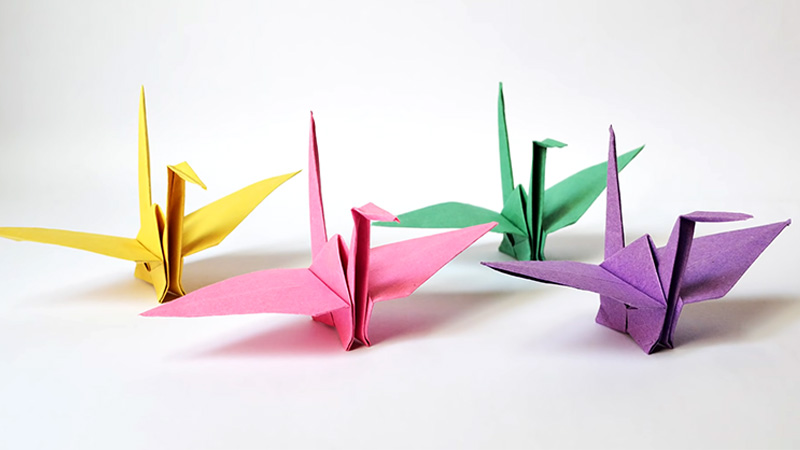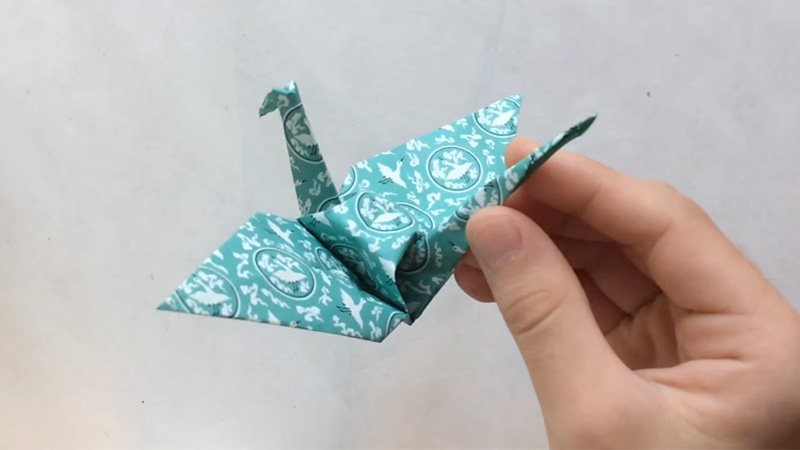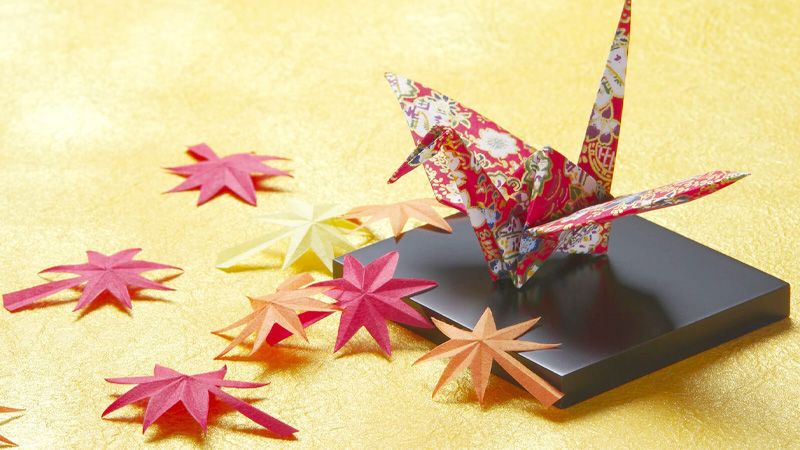Origami, the ancient Japanese art of paper folding, is a captivating craft that has delighted people of all ages for centuries. Among the many origami creations, the origami crane holds a special place, symbolizing hope, peace, and grace.
In just a few folds and a little practice, you can transform a simple square sheet of Paper into an elegant and iconic bird.
Origami cranes are not only aesthetically pleasing but also offer a sense of accomplishment when crafted with care.
This art form, rooted in Japanese culture, has found a place in the hearts of people worldwide, making it a cherished pastime and a meaningful way to express sentiments through a tangible, delicate form.
This guide will take you through How To Make An Origami Crane, offering insights into the techniques and nuances that make this art form so enchanting.

How To Make An Origami Crane?
Creating an origami crane is a delightful and rewarding craft project. Here are some important easy steps, each accompanied by a brief description to guide you through the process:
Start with a Square Sheet of Paper
Begin by selecting a square sheet of origami paper or cutting a regular sheet into a square. Place it in a diamond shape with the colored side facing down.
Fold Diagonally
Fold the Paper in Half diagonally, lining up the edges accurately. Press firmly along the fold to create a sharp crease. Unfold the Paper to its square shape.
Fold Diagonally Again
Fold the Paper diagonally in the opposite direction, creating another crease. Unfold it again, returning to the square shape.
Fold in Half Horizontally
Now, fold the paper in half horizontally, matching the top edge to the bottom edge. Press along the fold and then unfold it.
Fold in Half Vertically
Fold the Paper in Half vertically, bringing the right edge to meet the left edge. Press along the fold, then unfold it again.
Collapse the Paper into a Triangle
Gently pinch the Paper together at the top, where all the folded lines intersect. As you do this, the Paper will naturally collapse into a triangle shape.
Create the Crane’s Neck and Tail
Fold down the top flap of the triangle along the crease, forming the crane’s neck. Then, fold up the bottom flap to create the tail.
Form the Wings
Lift one layer of Paper on each side, creating the crane’s wings. Adjust the wings’ position and angle to your liking.
Shape the Head and Beak
To shape the crane’s head, fold down a small triangle at the top of the neck. You can also fold a tiny triangle from the neck to create the beak. Finally, adjust the wings and tail to achieve the desired look for your origami crane.
With these easy steps, you’ve successfully created an origami crane. Remember, practice makes perfect, so don’t be discouraged if your first crane isn’t perfect.
Origami is an art that improves with patience and experience. Enjoy the process and the sense of accomplishment that comes with each crane you fold.
Common Mistakes People Make While Making An Origami Crane

Origami cranes can be a bit tricky, especially for beginners. Here are some common mistakes people often make while making origami cranes, along with explanations for each:
Using the Wrong Paper Size
One of the most frequent mistakes is starting with the incorrect paper size. Make sure you use a square sheet of Paper, as non-square shapes can lead to difficulties in folding and shaping your crane.
Inaccurate Folding
Failing to make precise folds can result in an uneven and lopsided crane. Be sure to align the edges and corners carefully when folding to maintain symmetry.
Not Creasing the Folds Properly
Inadequate creasing can lead to a crane that doesn’t hold its shape well. Make sure to press down firmly along the creases to create crisp and clean folds.
Skipping the Preliminary Folds
The diagonal and horizontal/vertical folds at the beginning are essential for achieving the correct base shape. Skipping these can make the later steps more challenging.
Over-folding or Under-folding
Folding the Paper too hard or not hard enough can lead to problems down the line. Strike a balance between applying enough pressure to secure the fold without damaging the Paper.
Misshaping the Neck and Beak
Creating the crane’s neck and beak requires precise folds. Mistakes in this area can affect the crane’s overall appearance. Take your time when shaping these features.
Uneven Wing and Tail Placement
Placing the wings and tail at uneven angles can make your crane look asymmetrical. Ensure that both sides are balanced by paying attention to their positioning.
Rushing the Process
Origami requires patience and precision. Rushing through the steps can lead to errors. Take your time to fold carefully and thoughtfully.
Tightening Folds Too Early:
Avoid tightening your folds too early in the process. Some folds need to be loose initially to allow for later adjustments. Tightening them prematurely can make it difficult to shape the crane correctly.
By being aware of these common mistakes and taking your time to fold accurately, you can improve your origami crane-making skills and create beautiful, well-crafted cranes.
Practice and patience will help you overcome these challenges and achieve better results with each attempt.
How Long Do Origami Cranes Last?

The longevity of origami cranes can vary depending on several factors, including the quality of Paper used, environmental conditions, and handling.
Here are some scenarios that can influence how long origami cranes last:
Temporary Decorations
Origami cranes used as temporary decorations for events or parties typically last for the duration of the event or a few days at most. Afterward, they may become creased or lose their shape due to handling or environmental factors.
Display in a Controlled Environment
When origami cranes are displayed indoors in a controlled environment with stable humidity and temperature, they can last for months or even years. Properly crafted and well-protected cranes are less prone to damage.
Exposure to Moisture
Origami cranes are sensitive to moisture. If they come into contact with water or are exposed to high humidity, they can quickly lose their shape and become damaged. In such conditions, their lifespan may be reduced to hours or days.
Handling and Wear
Frequent handling and manipulation of origami cranes can lead to wear and tear. Over time, the Paper may become worn at the creases, and the crane may lose its original crispness. Displaying them in a protective case or shadow box can help prolong their life.
Folding Technique and Paper Quality
The skill of the origami artist and the quality of Paper used play a significant role in how long origami cranes last.
Cranes folded with precision and care using high-quality origami paper tend to hold their shape and last longer than those hastily made with low-quality Paper.
The lifespan of origami cranes can range from a few hours to several years, depending on how they are used, displayed, and cared for.
If you wish to preserve your origami cranes for an extended period, it’s essential to consider the environmental conditions and handle them gently to prevent damage.
FAQ
Start with a square piece of origami paper, coloured side down. Fold it diagonally both ways to create an “X” shape on the Paper.
These preliminary folds create guidelines that help in later steps, ensuring the crane’s correct proportions.
To shape the neck, fold down a small triangle at the top, and for the beak, fold a tiny triangle from the neck.
While origami paper is recommended for its square shape and durability, you can use regular Paper, but it may be less forgiving and more prone to tearing.
Origami cranes can be displayed individually or in groups. Consider shadow boxes, mobiles, or attaching them to strings for a decorative effect.
Displaying them indoors, away from moisture and direct sunlight, will help preserve their longevity.
Conclusion
In the realm of creative expression, few crafts possess the timeless charm and symbolism of origami cranes.
Crafting an origami crane is not just about folding Paper; it’s about patience, precision, and the satisfaction of transforming a simple sheet into an elegant symbol of hope and peace.
As you’ve discovered in this guide, mastering the art of making an origami crane requires a gentle touch, an eye for symmetry, and a willingness to learn from your mistakes.
The journey of folding an origami crane is more than just a craft project; it’s a testament to the power of human creativity and ingenuity. With each fold, you create a work of art that carries with it the tradition and culture of Japan while also serving as a canvas for your own personal touch.
Leave a Reply